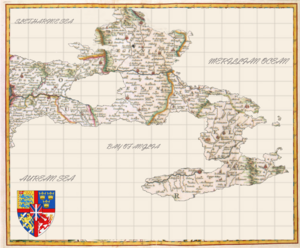History of Angland: Difference between revisions
No edit summary |
|||
| Line 21: | Line 21: | ||
==Prehistory== | ==Prehistory== | ||
===Stone Age Anglica=== | ===Stone Age Anglica=== | ||
Angland contains evidence of being the first in the {{wp|eastern hemisphere}} to have been inhabited by humans, with the first traces of human life dating back to around 600,000 years ago, during the [[Great Hominid Migration]]. Continuous human habitation in Angland dates to around 13,000 years ago (see [[Keaneswell]]), at the end of the Last Glacial Period. | |||
===Later Prehistory=== | ===Later Prehistory=== | ||
===Genetic Markers of Pan-Vetullian Culture=== | ===Genetic Markers of Pan-Vetullian Culture=== | ||
Revision as of 20:34, 27 January 2023
Part of a series on the |
|---|
| History of Angland |
 |
The history of Angland dates to contact the pre-Remillian peoples of the Aurean coast of the Anglican Peninsula made with the Remillians and Carcedonians and the first writing systems known as Paleoanglican scripts were developed. During Classical Antiquity, the peninsula was the site of multiple successive colonizations of Remillians, Anglo-Herulians and Wittekings. Native peoples of the peninsula, such as the Robergiais people, intermingled with the colonizers to create a uniquely Anglican culture. The Remillians referred to the entire Peninsula as Angligaullica, from where the modern name of Angland originates.
Prehistory
Stone Age Anglica
Angland contains evidence of being the first in the eastern hemisphere to have been inhabited by humans, with the first traces of human life dating back to around 600,000 years ago, during the Great Hominid Migration. Continuous human habitation in Angland dates to around 13,000 years ago (see Keaneswell), at the end of the Last Glacial Period.